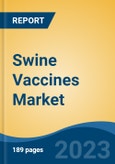Speak directly to the analyst to clarify any post sales queries you may have.
10% Free customizationThis report comes with 10% free customization, enabling you to add data that meets your specific business needs.
Key Market Drivers
Rising Demand for Pork
The world's population is steadily increasing, and with it, the demand for protein-rich foods like pork is on the rise. As more people move to urban areas, their dietary preferences tend to shift towards meat-based diets. This urbanization trend amplifies the demand for pork products, leading to larger swine farming operations. To meet this burgeoning demand, farmers rely on swine vaccines to ensure the health and productivity of their herds.Emerging markets in regions such as Asia, Latin America, and Africa are witnessing a rapid expansion of their middle-class populations. As incomes rise, so does the consumption of animal protein, including pork. This socio-economic shift is a major driver of increased demand for pork and, consequently, for swine vaccines. To meet the quality and safety standards demanded by this growing middle-class consumer base, swine farmers invest in disease prevention through vaccination.
Food security is a pressing concern in a world that needs to feed a growing population sustainably. Pork is an efficient source of protein, as pigs can convert feed into meat relatively quickly compared to other livestock. Ensuring the health and well-being of swine herds through vaccination is a key component of sustainable swine farming. Healthy pigs mean higher yields, reduced waste, and a more sustainable food supply chain.
Key Market Challenges
Emerging Diseases and Pathogens
The swine industry faces an ongoing threat from emerging diseases and evolving strains of existing pathogens. New diseases, such as African swine fever (ASF) and novel strains of influenza, can have devastating consequences for swine herds. Developing effective vaccines to combat these emerging threats is a constant challenge for vaccine manufacturers.Key Market Trends
Precision Vaccination
One of the emerging trends in the swine vaccines market is precision vaccination. Traditional vaccines provide broad protection against a range of pathogens, but advances in vaccine technology now allow for more precise targeting of specific diseases. This trend helps swine farmers address unique disease challenges and reduce the potential for adverse reactions.Key Market Players
- Merck & Co Inc
- Zoetis Inc
- Boehringer Ingelheim GmbH
- Elanco Animal Health Inc
- Indian Immunologicals Ltd
- Biogénesis Bagó SA
- Phibro Animal Health Corp
- Laboratorios HIPRA SA
- Virbac SA
Report Scope:
In this report, the Global Swine Vaccines Market has been segmented into the following categories, in addition to the industry trends which have also been detailed below:Swine Vaccines Market, By Product:
- Attenuated Live Vaccines
- DNA Vaccines
- Inactivated Vaccines
- Recombinant Vaccines
- Subunit Vaccines
Swine Vaccines Market, By Type:
- Actinobacillus Pleuropneumoniae
- Classical Swine Fever
- Foot & Mouth Disease
- PEDV
- Porcine Circovirus Type 2
- Porcine Parvovirus
- PRRS
- Pseudorabies
- Swine Influenza
Swine Vaccines Market, By Target Disease:
- Arthritis
- Bordetella Rhinitis
- Diarrhea
- Foot & Mouth Disease
- Porcine Circovirus Associated Disease
- Porcine Reproductive & Respiratory Syndrome
- Pseudorabies
- Swine Influenza
Swine Vaccines Market, By Region:
- North America
- United States
- Canada
- Mexico
- Europe
- Germany
- United Kingdom
- France
- Italy
- Spain
- Asia-Pacific
- China
- Japan
- India
- Australia
- South Korea
- South America
- Brazil
- Argentina
- Colombia
- Middle East & Africa
- South Africa
- Saudi Arabia
- UAE
- Kuwait
Competitive Landscape
Company Profiles: Detailed analysis of the major companies present in the Global Swine Vaccines Market.Available Customizations:
With the given market data, the publisher offers customizations according to a company's specific needs. The following customization options are available for the report.Company Information
- Detailed analysis and profiling of additional market players (up to five).
This product will be delivered within 1-3 business days.
Table of Contents
Companies Mentioned
- Merck & Co Inc
- Zoetis Inc
- Boehringer Ingelheim GmbH
- Elanco Animal Health Inc
- Indian Immunologicals Ltd
- Biogénesis Bagó SA
- Phibro Animal Health Corp
- Laboratorios HIPRA SA
- Virbac SA
Table Information
| Report Attribute | Details |
|---|---|
| No. of Pages | 180 |
| Published | March 2025 |
| Forecast Period | 2024 - 2030 |
| Estimated Market Value ( USD | $ 1.32 Billion |
| Forecasted Market Value ( USD | $ 1.74 Billion |
| Compound Annual Growth Rate | 4.8% |
| Regions Covered | Global |
| No. of Companies Mentioned | 9 |









